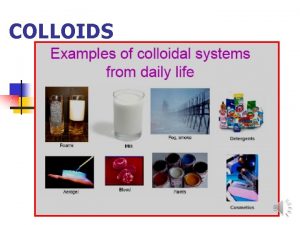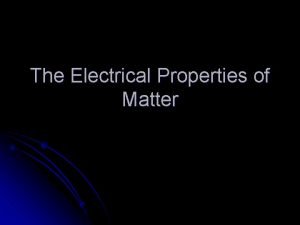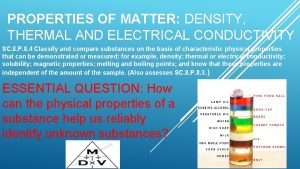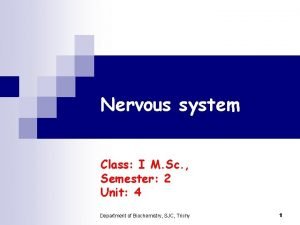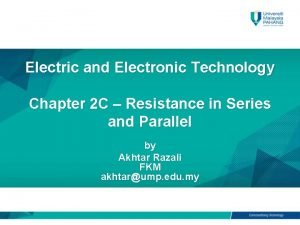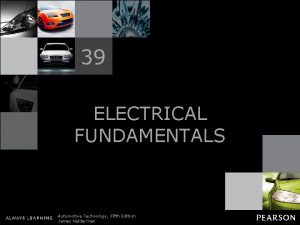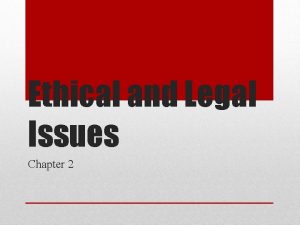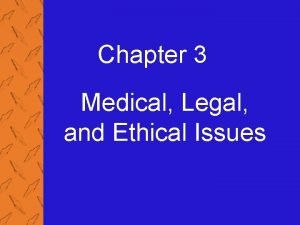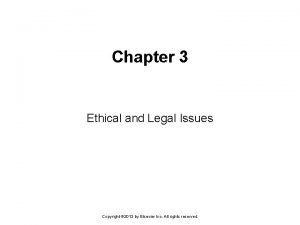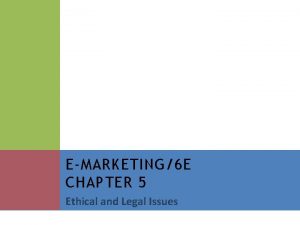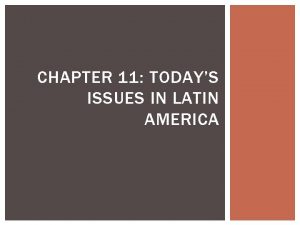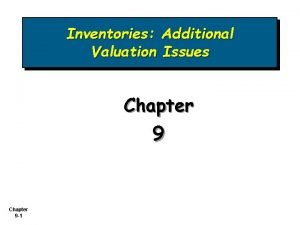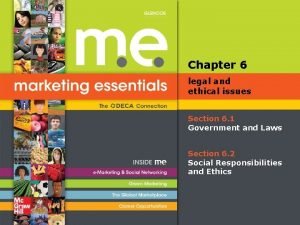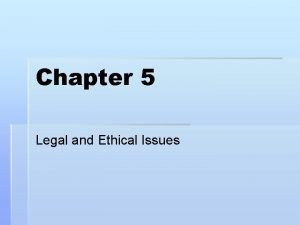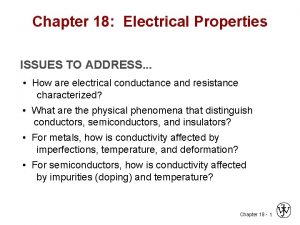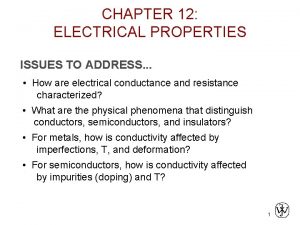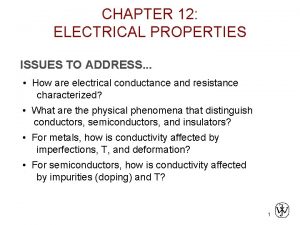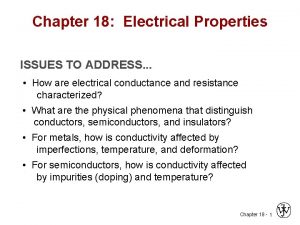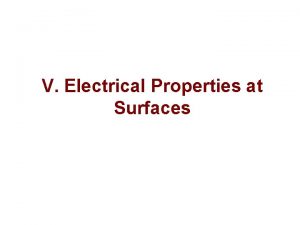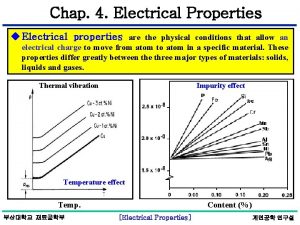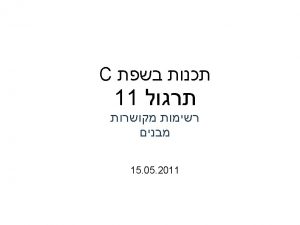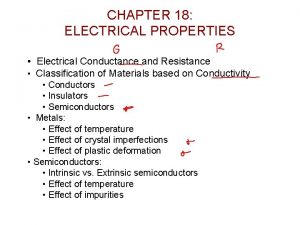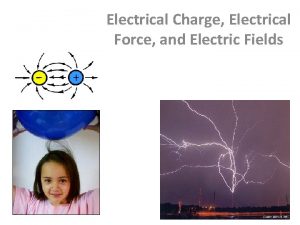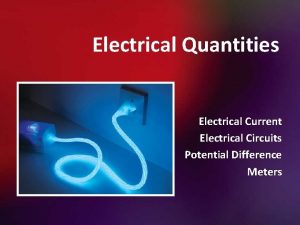Chapter 18 Electrical Properties ISSUES TO ADDRESS How
























- Slides: 24

Chapter 18: Electrical Properties ISSUES TO ADDRESS. . . • How are electrical conductance and resistance characterized? • What are the physical phenomena that distinguish conductors, semiconductors, and insulators? • For metals, how is conductivity affected by imperfections, temperature, and deformation? • For semiconductors, how is conductivity affected by impurities (doping) and temperature? Chapter 18 - 1

Ohm’s Law Chapter 18 -

Electrical Conduction • Ohm's Law: V=IR voltage drop (volts = J/C) resistance (Ohms) current (amps = C/s) C = Coulomb • Resistivity, : -- a material property that is independent of sample size and geometry • Conductivity, surface area of current flow path length Chapter 18 - 3

Electrical Properties • Which will have the greater resistance? 2 D 2 D • Analogous to flow of water in a pipe • Resistance depends on sample geometry and size. Chapter 18 - 4

Definitions Further definitions J= <= another way to state Ohm’s law J current density electric field potential = V/ J = (V/ ) Electron flux conductivity voltage gradient Chapter 18 - 5

Conductivity: Comparison • Room temperature values (Ohm-m)-1 = ( - m)-1 METALS CERAMICS conductors -10 Silver 6. 8 x 10 7 Soda-lime glass 10 -10 -11 Copper 6. 0 x 10 7 Concrete 10 -9 Iron 1. 0 x 10 7 Aluminum oxide <10 -13 SEMICONDUCTORS POLYMERS Polystyrene Silicon 4 x 10 -4 Polyethylene Germanium 2 x 10 0 Ga. As 10 -6 semiconductors -14 <10 10 -15 -10 -17 insulators Selected values from Tables 18. 1, 18. 3, and 18. 4, Callister & Rethwisch 8 e. Chapter 18 - 6

Example: Conductivity Problem What is the minimum diameter (D) of the wire so that V < 1. 5 V? I = 2. 5 A Cu wire - + V 100 m < 1. 5 V 2. 5 A 6. 07 x 107 (Ohm-m)-1 Solve to get D > 1. 87 mm Chapter 18 - 7

Chapter 18 - 8

18. 2 An aluminum wire 10 m long must experience a voltage drop of less than 1. 0 V when a current of 5 A passes through it. Using the data in Table 18. 1, compute the minimum diameter of the wire. Chapter 18 - 9

Electron Energy Band Structures Adapted from Fig. 18. 2, Callister & Rethwisch 8 e. Chapter 18 - 10

Band Structure Representation Adapted from Fig. 18. 3, Callister & Rethwisch 8 e. Chapter 18 - 11

Conduction & Electron Transport • Metals (Conductors): partly filled band filled states - partially filled band - empty band that overlaps filled band filled states -- for metals empty energy states are adjacent to filled states. -- thermal energy Partially filled band Overlapping bands excites electrons Energy into empty higher empty energy states. band empty -- two types of band GAP band structures for metals filled band Chapter 18 - 12

Energy Band Structures: Insulators & Semiconductors • Semiconductors: -- wide band gap (> 2 e. V) -- few electrons excited across band gap empty Energy conduction band filled states GAP filled valence band filled band -- narrow band gap (< 2 e. V) -- more electrons excited across band gap Energy empty conduction band ? GAP filled states • Insulators: filled valence band filled band Chapter 18 - 13

Chapter 18 -

Electron Mobility Chapter 18 -

Metals: Influence of Temperature and Impurities on Resistivity • Presence of imperfections increases resistivity (10 -8 Ohm-m) Resistivity, -- grain boundaries -- dislocations -- impurity atoms -- vacancies 6 5 4 3 2 Cu i %N t a 2 . 3 +3 u C d e form de d i 1 0 These act to scatter electrons so that they take a less direct path. t -200 12 + 1. Cu i t%N a 12 + 1. i t%N a u C ” e ur “P -100 0 T (ºC) Adapted from Fig. 18. 8, Callister & Rethwisch 8 e. (Fig. 18. 8 adapted from J. O. Linde, Ann. Physik 5, p. 219 (1932); and C. A. Wert and R. M. Thomson, Physics of Solids, 2 nd ed. , Mc. Graw-Hill Book Company, New York, 1970. ) • Resistivity increases with: -- temperature -- wt% impurity -- %CW = thermal + impurity + deformation Chapter 18 - 16

Estimating Conductivity • Question: 180 160 140 125 120 100 21 wt% Ni 80 60 0 10 20 30 40 50 Resistivity, (10 -8 Ohm-m) Yield strength (MPa) -- Estimate the electrical conductivity of a Cu-Ni alloy that has a yield strength of 125 MPa. wt% Ni, (Concentration C) Adapted from Fig. 18. 9, Callister & Rethwisch 8 e. 50 40 30 20 10 0 0 10 20 30 40 50 wt% Ni, (Concentration C) Adapted from Fig. 7. 16(b), Callister & Rethwisch 8 e. From step 1: CNi = 21 wt% Ni Chapter 18 - 17

Charge Carriers in Insulators and Semiconductors Adapted from Fig. 18. 6(b), Callister & Rethwisch 8 e. Two types of electronic charge carriers: Free Electron – negative charge – in conduction band Hole – positive charge – vacant electron state in the valence band Move at different speeds - drift velocities Chapter 18 - 18

Intrinsic Semiconductors • Pure material semiconductors: e. g. , silicon & germanium – Group IVA materials • Compound semiconductors – III-V compounds • Ex: Ga. As & In. Sb – II-VI compounds • Ex: Cd. S & Zn. Te – The wider the electronegativity difference between the elements the wider the energy gap. Chapter 18 - 19

Intrinsic Semiconduction in Terms of Electron and Hole Migration • Electrical Conductivity given by: # holes/m 3 hole mobility # electrons/m 3 electron mobility Chapter 18 -

Room Temperature Values Chapter 18 -

Number of Charge Carriers Intrinsic Conductivity • for intrinsic semiconductor n = p = ni|e|( e + h) • Ex: Ga. As For Si ni = 4. 8 x 1024 m-3 ni = 1. 3 x 1016 m-3 Chapter 18 - 22

Intrinsic Semiconductors: Conductivity vs T • Data for Pure Silicon: -- increases with T -- opposite to metals material Si Ge Ga. P Cd. S band gap (e. V) 1. 11 0. 67 2. 25 2. 40 Selected values from Table 18. 3, Callister & Rethwisch 8 e. Adapted from Fig. 18. 16, Callister & Rethwisch 8 e. Chapter 18 - 23

18. 21 At room temperature the electrical conductivity of Pb. Te is 500 (Ω-m)– 1, whereas the electron and hole mobilities are 0. 16 and 0. 075 m 2/V-s, respectively. Compute the intrinsic carrier concentration for Pb. Te at room temperature. Chapter 18 - 24
 Physical memory vs logical memory
Physical memory vs logical memory Explain how dishes on a menu address environmental issues
Explain how dishes on a menu address environmental issues Eduqas hospitality and catering
Eduqas hospitality and catering Electrical engineering environmental issues
Electrical engineering environmental issues Kinetic properties of colloids
Kinetic properties of colloids Physiological properties of nerve fibre
Physiological properties of nerve fibre Electrical properties of matter
Electrical properties of matter Electrical properties of matter
Electrical properties of matter Properties of nerve fibre
Properties of nerve fibre Intensive vs extensive
Intensive vs extensive Chemical property definition
Chemical property definition Define electrical engineering
Define electrical engineering Electrical technology chapter 2
Electrical technology chapter 2 Chapter 39 electrical fundamentals
Chapter 39 electrical fundamentals Chapter 20 today's issues in africa
Chapter 20 today's issues in africa Chapter 2 ethical and legal issues
Chapter 2 ethical and legal issues Chapter 3 medical legal and ethical issues
Chapter 3 medical legal and ethical issues Chapter 3 legal and ethical issues
Chapter 3 legal and ethical issues Chapter 20 today's issues in africa
Chapter 20 today's issues in africa Legal and ethical issues chapter 5
Legal and ethical issues chapter 5 Emt chapter 3 medical legal and ethical issues
Emt chapter 3 medical legal and ethical issues Chapter 11 today's issues in latin america
Chapter 11 today's issues in latin america Chapter 9 inventories additional valuation issues
Chapter 9 inventories additional valuation issues Chapter 6 legal and ethical issues
Chapter 6 legal and ethical issues Chapter 5 legal and ethical responsibilities
Chapter 5 legal and ethical responsibilities




